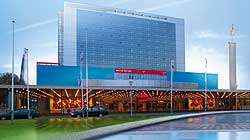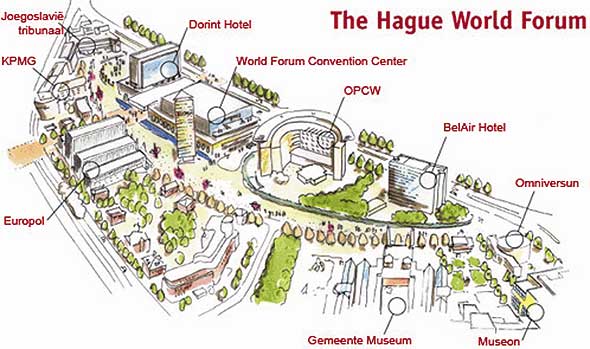There are two distinct groups among the Indian community in the Netherlands—people of Indian origin who originally migrated from India to Suriname as indentured labourers, and later migrated to the Netherlands, and a more recent wave of Indian professionals from India. The Indian community is estimated at 215,000, about 1.35 per cent of the total population of 15.9 million.
The colonial connection played a role in Indian migration to the Netherlands. After the abolition of slavery in 1834, the colonial government and estate owners in Suriname, then a Dutch colony, began looking for alternative sources of cheap and bonded
labour. Under a Treaty signed in 1870 between the Netherlands and Great Britain, the Dutch colonial Government was permitted to recruit Indian
labourers. Accordingly, from 1873 onwards, a large number of Indian indentured labourers traveled to Suriname.
|
There are over 200 yoga schools in the Netherlands. There are three companies in the Netherlands producing TV programmes on India. Their documentaries are telecast on local TV stations. There are a large number of Indian restaurants in the country operated by the Indo-Surinamese community |
The approach of Suriname’s independence sharpened apprehensions among the people of Indian origin regarding their future status and economic and political rights. More than 1/3 of the PIO population availed of a provision in the Independence Act permitting Surinamese to migrate to the Netherlands before the transfer of power in 1975. Today, the Surinamese Indian community in the Netherlands, which calls itself the Surinamese Hindustanis, numbers approximately 200,000, while the more recent arrivals from India number around 15,000.
Economic Profile
Like other countries in Western Europe, the Netherlands enjoyed an uninterrupted two decades of economic growth in the 1950s and 60s, giving rise to an acute demand for highly-skilled labour. The number of Indian families increased from 10 in 1960 to 250 by the end of 1970. Moreover, as the scope for imports of textiles, leather products and other consumer goods from developing countries increased, a number of NRIs set up trading companies in the Netherlands. Finally, expanding Dutch universities attracted some highly qualified and experienced Indian scientists, educationists and researchers. Thus there was a sizable influx of Indians to the Netherlands and the community’s size increased to the present level of 15,000.
Though the people of Indian origin from Suriname significantly outnumber and precede those who went to the Netherlands from India more recently, the latter have also made their presence felt. The NRI community in the Netherlands mostly consists of highly qualified engineers, doctors, scientists, businessmen and other professionals. Most of them occupy senior positions in their organizations. In terms of income, the majority of them can be grouped among the top 10% of the Dutch population. Their contributions are appreciated by the Dutch community and some of them have also been bestowed with special recognition and honours.
Besides the above, the Dutch (and Belgians) have been adopting Indian children on a regular basis, for which exact figures are not available. No instances of maltreatment have been reported. The numbers of these children will grow and they will form a distinct group that may like to renew its links with India in the future.
|

|
World Forum, The Hague — Venue for PBD Europe in September 2009 |
Socio-cultural profile
The Surinamese Indians in the Netherlands share similar characteristics with the people of Indian origin in Suriname and other Caribbean countries. One distinctive feature of the Surinamese-Indian community in the Netherlands is that even though they left Suriname over 25 years ago, they still speak Sarnami Hindi, the language they spoke in Suriname. Sarnami Hindi is a mixture of Bhojpuri, which they called Hindustani, and Awadhi, with a smattering of Dutch and English.
In spite of their continuing attachment to their roots, the Surinamese Indians have integrated well in Holland, and are making a useful contribution to the country’s economic and social life. The majority live in Amsterdam, The Hague and Rotterdam and are found in businesses, education, medicine, law and other service industries. Similarly, Surinamese Indian musicians, artists, sculptors, sports persons, journalists, actors and singers have made a considerable contribution in the socio-cultural spheres. The Indology Department at the Leiden University conducts seminars and lectures on Indian culture. The Nederland Hindi Parishad, a Surinamese Indian organization, is actively propagating teaching of Hindi language in various schools run by the community. Due to their efforts, Hindi will now be taught as an optional subject in selected primary schools within the Netherlands. There are over 200 yoga schools in the Netherlands. There are three companies in the Netherlands producing TV programmes on India. Their documentaries are telecast on local TV stations. There are a large number of Indian restaurants in the country operated by the Indo-Surinamese community.
Although there is no separate political party representing the Surinamese Indians, some of them are active members of Dutch political parties. Active participation by the Surinamese community in the Dutch political scene has helped in sensitizing the Dutch Government to the concerns of the Indian community.

A distinctive characteristic of the NRI community in the Netherlands is its unity. Despite the fact that members of the NRI community hail from different parts of India and speak different Indian languages, there is only one socio-cultural organization, the Netherlands-India Association that represents their interests. This association organizes cultural programmes showcasing cultures of different parts of India, celebrates Diwali, and other Indian festivals, and also invites scholars and artists from various regions of India. There are other NRI organizations devoted to India and Indian culture such as music schools, organizations for researchers in India, and also an Indian Ladies Club and Foundation for Critical Choices for India. The latter is a think-tank that prepares special studies on issues critical to India and organizes international seminars and other activities to focus the attention of local policy makers.
Despite their common origin and cultural heritage, the two groups of Indians in the Netherlands have different characteristics and cultural nuances and also differ in the degree of their integration with wider Dutch society. The Surinamese Indians are more integrated with the local society, partly due to their knowledge of the Dutch language and their familiarity with the Dutch system from colonial times. Indians who have migrated to the Netherlands initially faced considerable problems due to the language barrier. However, since a majority of them were well-educated professionals, they were soon able to carve their niche in Dutch society and earn the acceptance and respect of local people. During the interactions between the two groups and the High-Level Committee, it was observed that the only common language with the Surinamese Indian community was Hindi, while with the NRI community, it was English.
While there is scope for greater interaction between the two groups, members of the NRI community and the Surinamese Indian community come together at festivals and other occasions. The two groups have cooperated in setting up of a statue of Mahatma Gandhi at Amsterdam, for which the Surinamese Indians provided the land, while the Indians did the planning and the actual execution. Both Indo-Surinamese and NRIs have contributed generously for relief assistance following the Orissa cyclone, Kargil War and Gujarat earthquake, channeling funds mostly through the PM’s National Relief Fund. Last minute changes in policy decisions, however, made them feel that their efforts did not achieve the desire result, nor were they given due recognition by Indian authorities. A number of Indian and Indo-Surinamese artists are running private institutes for teaching and propagating Indian classical music and dance. While there is a hall gifted by the Dutch Government as a permanent facility to the Indo-Surinamese, both communities have jointly sought some Indian support for building a common Indian cultural centre that will act as a hub for activities promoting a better and more authentic understanding of India.
|